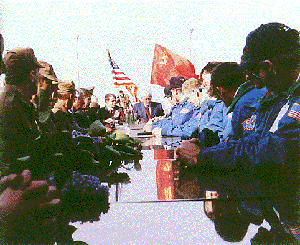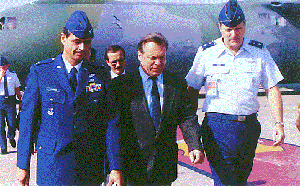
|
|
As the
United States' principal agency for conducting on-site
inspections in these arms control treaties, the On-Site
Inspection Agency participated directly in many of these
new developments. General Parker and General Medvedev
joined the multinational CFE trial inspection teams,
reviewing in detail the inspection protocols with their
senior team chiefs, linguists, and inspectors. Both
directors served as on-site inspectors on the START
exhibition teams, traveling to military bases in the
United States and Russia to inspect, measure, and record
the technical characteristics of the missile and bomber
systems. Both generals participated in international
meetings and seminars, discussing with experts and the
public their INF experiences learned from conducting more
than 850 on-site inspections. In Europe, both Parker and
Medvedev participated in multinational planning meetings
on implementing the inspection regime of the CFE Treaty. In
May, General Medvedev traveled from Moscow to Washington
where he joined with General Parker in a briefing to the
Middle East Regional Security and Arms Control Group
which included representatives from Algeria, Bahrain,
Egypt, Israel, Jordan, Kuwait, Morocco, Oman, Qatar,
Saudi Arabia, United Arab Emirates, and Yemen. Richard A.
Clarke, Assistant Secretary of State for
Political-Military Affairs, hosted the 3-day meeting
which focused on the methods and concepts in arms control
from the U.S.-Soviet experience. Clarke characterized the
meeting: "I think the briefing on the mission and
work of OSIA [was] of great benefit to the Middle East
states familiarization process."28
In June, in a somewhat similar vein, Dr. Edward M.
Ifft, OSIA's Deputy Director for External Affairs, led a
small group of experienced team chiefs, linguists, and
commanders to seven of the successor states of the former
Soviet Union. In the capital cities of the Ukraine,
Belarus, Kazakhstan, Moldava, Georgia, Armenia, and
Azerbaijan, they briefed the senior military and
diplomatic staffs on the CFE Treaty, on-site inspection
concepts and protocols, and the experiences learned from
the INF Treaty.
Perhaps the clearest concrete indication of continuity
occurred in July 1992. The Conventional Armed Forces in
Europe Treaty entered into force, beginning mandatory
data exchanges, on-site inspections, and scheduled
reductions of military arms on the European continent,
from the Urals to the Atlantic. With the collapse of the
Soviet Union and the creation of new independent states,
the number of treaty signatories increased to 29 nations.
Representatives of these nations met in Helsinki, Finland
at the Conference on Security and Cooperation in Europe
and exchanged the treaty documents.29
The actual date for the CFE Treaty's entry into
force was July 17, 1992, the same day the 120-day
baseline inspection period began. Just as with the INF
Treaty, United States' inspection and escort teams were
poised to inaugurate the CFE Treaty baseline inspections.
U.S. Army Lt. Colonel Guy White led the first American
CFE team as they inspected the Russian Army's 22nd
Central Reserve Depot at Buy, Russia.30
The nine-member team included officers and
non-commissioned officers, linguists and armament
specialists, team and subgroup leaders. During the
inspection, Colonel White's team identified, counted, and
recorded more than l,200 Russian tanks and other
treaty-limited equipment items.31
This inspection was just the beginning, over the 120-day
baseline period the United States and the other 15 NATO
nations would be inspecting a portion of the more than
1,000 declared sites where conventional weapons were
located in the former Warsaw Pact nations. General
Parker, OSIA's Director, was an inspector on that first
CFE inspection team. Just before departing for Russia, a
reporter asked him to compare previous arms control
treaties with the CFE Treaty. Parker explained the
treaty's size, complexity, and multinational aspects, and
then concluded: "The CFE Treaty is the accumulation
of just about every treaty worked out in the past few
years."32
When one thinks about the breadth of these new arms
control treaties, agreements, and developments, they
dwarf the scope of the INF Treaty. All, however, were
indebted to that treaty and the precedents it
established. For in the final analysis, the INF Treaty
can be considered a template for subsequent arms control
agreements; a template carefully drawn, tempered through
implementation, and closely watched for flaws and
ambiguities. Like any good template, the pattern
established for one set of materials could, if properly
done, be applied to a different set. Perhaps it is time
to incorporate into our knowledge of arms control
treaties, the efforts of those nations and people who
carried out "On-Site Inspections Under the INF
Treaty."
|

